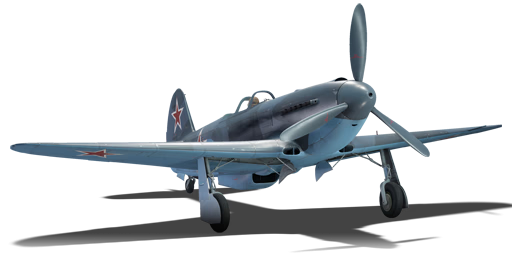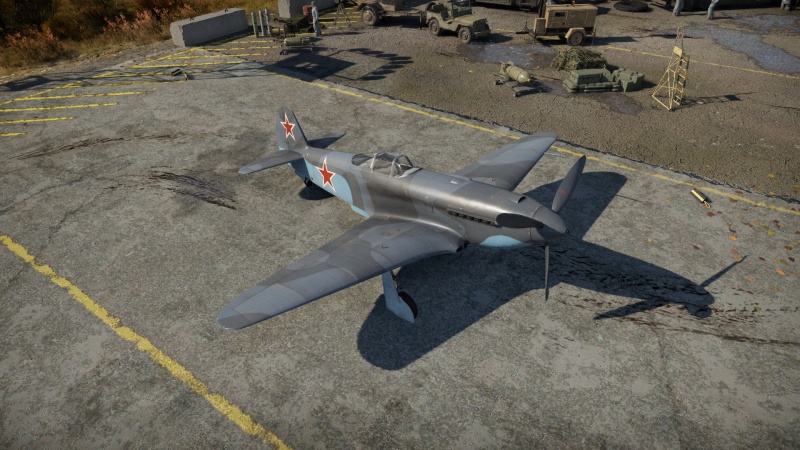Yak-3 (VK-107)
| This page is about the Soviet premium fighter Yak-3 (VK-107). For other uses, see Yak-3 (Family). |
Contents
Description
The Yak-3 (VK-107) is a premium rank IV Soviet fighter with a battle rating of 5.7 (AB/RB) and 6.3 (SB). It was introduced in Update 1.51 "Cold Steel".
General info
Flight performance
Describe how the aircraft behaves in the air. Speed, manoeuvrability, acceleration and allowable loads - these are the most important characteristics of the vehicle.
| Characteristics | Max Speed (km/h at 5,900 m) |
Max altitude (metres) |
Turn time (seconds) |
Rate of climb (metres/second) |
Take-off run (metres) | |||
|---|---|---|---|---|---|---|---|---|
| AB | RB | AB | RB | AB | RB | |||
| Stock | ___ | ___ | 10400 | __._ | __._ | __._ | __._ | 360 |
| Upgraded | 739 | 719 | 18.8 | 18.9 | 28.1 | 23.6 | ||
Details
| Features | ||||
|---|---|---|---|---|
| Combat flaps | Take-off flaps | Landing flaps | Air brakes | Arrestor gear |
| X | X | ✓ | X | X |
| Limits | ||||||
|---|---|---|---|---|---|---|
| Wings (km/h) | Gear (km/h) | Flaps (km/h) | Max Static G | |||
| Combat | Take-off | Landing | + | - | ||
| 0 | 320 | N/A | N/A | 280 | ~11 | ~8 |
| Optimal velocities (km/h) | |||
|---|---|---|---|
| Ailerons | Rudder | Elevators | Radiator |
| < 380 | < 420 | < 490 | > 400 |
Survivability and armour
Examine the survivability of the aircraft. Note how vulnerable the structure is and how secure the pilot is, whether the fuel tanks are armoured, etc. Describe the armour, if there is any, and also mention the vulnerability of other critical aircraft systems.
Modifications and economy
Armaments
Offensive armament
The Yak-3 (VK-107) is armed with:
- 1 x 20 mm B-20M cannon, nose-mounted (120 rpg)
- 1 x 20 mm B-20S cannon, nose-mounted (120 rpg)
Usage in battles
Describe the tactics of playing in the aircraft, the features of using aircraft in a team and advice on tactics. Refrain from creating a "guide" - do not impose a single point of view, but instead, give the reader food for thought. Examine the most dangerous enemies and give recommendations on fighting them. If necessary, note the specifics of the game in different modes (AB, RB, SB).
Manual Engine Control
| MEC elements | ||||||
|---|---|---|---|---|---|---|
| Mixer | Pitch | Radiator | Supercharger | Turbocharger | ||
| Oil | Water | Type | ||||
| Controllable | Controllable Not auto controlled |
Controllable Not auto controlled |
Controllable Auto control available |
Separate | Controllable 2 gears |
Not controllable |
Pros and cons
Pros:
- Fantastic rate of climb (comparable to J2M3/5, Bf 109 K-4, Spitfire LF Mk IX, Spitfire F Mk 24, and P-51H)
- Excellent turn rate and good roll rate
- Controls are very responsive at most speeds
- Amazing acceleration when below 5,000 m (16,400 ft), it's even better than some early jets
- Excellent energy retention in manoeuvres and in general
- Very good top speed below 6 km altitude
- Small, fast, and agile target; makes it good at defensive manoeuvres
- Flaps deploy and retract quickly
- Nose-mounted armament, allows for precision at longer ranges without need of convergence
- May survive being set on fire once
Cons:
- Low top speed in a dive, the plane rips past 720 km/h IAS (450 mph)
- Control stiffening occurs at high speeds
- Fully deployed flaps break past 280 km/h IAS (175 mph)
- Engine performance is nothing special when above 6,000 m (19,600 ft)
- Engine overheats over 96% throttle, use 95% or less to cool down the engine
- Radiators eventually open at high throttle settings, adding significant drag
- Mediocre manoeuvrability at low speeds
- Low ammo count, only 120 rounds per gun with high rate of fire
- Guns are weak compared to most 20 mm cannons used by other nations
History
The idea to produce a new fighter for the Red Army Air Force went as far back as 1941. It was then that the Yakovlev Design Bureau presented the I-30 prototype, intended an alternative to the earlier Yak-1 design. However, the German invasion of the USSR, as well as aluminium shortages, meant that the project had to be put on hold. Yakovlev resumed the development in 1943 while working on an upgraded version of the Yak-1 fighter. This time, it was decided that a new aircraft should be produced to completely replace the Yak-1 and Yak-7 models.
By September 1943, yet another improved variant was ready, designated Yak-1M Dubler, on which the canvas skin on the tail section was replaced with 2mm plywood, and oil and water radiators were improved. The Dubler also had a new mastless antenna, a ring sight instead of a reflector sight, improved armour and a new propeller. Test pilots were impressed by the new prototype. Their report stated in part: "Yak-1M possessed excellent horizontal, and especially vertical, manoeuvrability. Top speed greatly improved compared to earlier serial-production Yaks. Despite the improved performance, the aircraft remains easy to fly and does not require extensive pilot training."
The new machine was dubbed as the Yak-3 and entered service with the Red Army Air Force in 1944. The Yak-3 was a further modification of the Yak-1, produced in 1944 and 1945, with a total of 4,848 built, and considered one of the best fighters of the war.
The new fighter quickly became very popular with Soviet pilots. They highly praised its solid armament of two Berezin UBS 12.7 mm machine guns and one ShVAK 20 mm cannon as well as ease of piloting and superb low-altitude performance. Marcel Albert, the top scoring French ace of World War II, cited the Yak-3 as one of the best fighters of the war, along with the P-51 Mustang and the Supermarine Spitfire. After the war, the Yak-3 was also used by the Air Forces of Socialist Yugoslavia and Poland.[1]
The Yak-3P was produced from April 1945 until mid-1946, armed with 3 × 20 mm Berezin B-20 cannon with 120 rounds for the middle cannon and 130 RPG for the side weapons. The three-cannon armament with full ammunition load was actually 11 kg (24 lb) lighter than that of a standard Yak-3, and the one-second burst mass of 3.52 kg (7.74 lb) was greater than that of most contemporary fighters. Starting in August 1945, all Yak-3 were produced in the Yak-3P configuration with a total of 596 built.
In-game description
The Yak-3 was a Soviet single-engine fighter of the WWII era. It was the first combat aircraft designed by Alexander Yakovlev's construction bureau. The Yak-3 was a further modification of the Yak-1, produced in 1944 and 1945, with a total of 4,848 built, and considered one of the best fighters of the war. In February 1943, a new Yak-1M variant was completed. It was a further development of the Yak-1, differing from it mainly in lower weight and smaller wing span.
By September 1943, yet another improved variant was ready, designated Yak-1M Dubler, on which the canvas skin on the tail section was replaced with 2mm plywood, and oil and water radiators were improved. The Dubler also had a new mastless antenna, a ring sight instead of a reflector sight, improved armor and a new propeller. Test pilots were impressed by the new prototype. Their report stated in part: "Yak-1M possessed excellent horizontal, and especially vertical, maneuverability. Top speed greatly improved compared to earlier serial-production Yaks. Despite improved performance, the aircraft remains easy to fly and does not require extensive pilot training." Therefore, the new modification went into production, receiving a new designation, Yak-3.
One of the most memorable air battles for the Yak-3 took place on 16th July 1944, when the plane showed it could confidently engage superior enemy forces. On that day, 10 Yak-3s met 8 Bf-109s and 4 FW-190s, with the battle eventually growing to 18 Soviet and 24 German planes. In the end, 15 German planes were shot down, for the loss of a single Yak-3.
Media
Excellent additions to the article would be video guides, screenshots from the game, and photos.
See also
Links to the articles on the War Thunder Wiki that you think will be useful for the reader, for example:
- reference to the series of the aircraft;
- links to approximate analogues of other nations and research trees.
External links
| A.S. Yakovlev Design Bureau (Яковлев Опытное конструкторское бюро) | |
|---|---|
| Fighters | |
| Yak-1 | Yak-1 · Yak-1B |
| Yak-3 | Yak-3 · Eremin's Yak-3(e) · Yak-3 (VK-107) · Yak-3P · Yak-3T · Yak-3U |
| Yak-7 | Yak-7B |
| Yak-9 | Yak-9 · Yak-9B · Yak-9K · Golovachev's Yak-9M · Yak-9P · Yak-9T · Yak-9U · Yak-9UT |
| Twin-engine fighters | I-29 |
| Jet fighters | |
| Yak-15 | Yak-15P · Yak-15 |
| Yak-17 | Yak-17 |
| Yak-23 | Yak-23 |
| Yak-30 | Yak-30D |
| Yak-141 | Yak-141 |
| Strike aircraft | |
| Yak-2 | Yak-2 KABB |
| Yak-38 | Yak-38 · Yak-38M |
| Bombers | Yak-4 |
| Jet bombers | Yak-28B |
| Foreign use | ▄Yak-3 · Challe's ▄Yak-9T · ◔Yak-9P |
| Captured | ▀Yak-1B |
| USSR fighters | |
|---|---|
| I-15 | I-15 WR · I-15 M-22 · I-15 M-25 · I-15bis · Krasnolutsky's I-15bis |
| I-153 M-62 · Zhukovsky's I-153-M62 · I-153P | |
| I-16 | I-16 type 5 · I-16 type 10 · I-16 type 18 · I-16 type 24 · I-16 type 27 · I-16 type 28 · I-180S |
| I-29 | I-29 |
| I-185 | I-185 (M-71) · I-185 (M-82) |
| I-225 | I-225 |
| ITP | ITP (M-1) |
| MiG-3 | MiG-3-15 · MiG-3-15 (BK) · MiG-3-34 |
| LaGG | I-301 · LaGG-3-4 · LaGG-3-8 · LaGG-3-11 · LaGG-3-23 · LaGG-3-34 · LaGG-3-35 · LaGG-3-66 |
| La | La-5 · La-5F · La-5FN · La-7 · Dolgushin's La-7 · La-7B-20 · La-9 · La-11 |
| Yak-1/7 | Yak-1 · Yak-1B · Yak-7B |
| Yak-3 | Yak-3 · Eremin's Yak-3(e) · Yak-3P · Yak-3T · Yak-3U · Yak-3 (VK-107) |
| Yak-9 | Yak-9 · Yak-9B · Golovachev's Yak-9M · Yak-9T · Yak-9K · Yak-9U · Yak-9UT · Yak-9P |
| Other countries | ▂P-40E-1 · ▂P-47D-27 · ▂Hurricane Mk IIB · ▂Fw 190 D-9 · ▂Spitfire Mk IXc |
| P-39 | ▂P-39K-1 · ▂Pokryshkin's P-39N-0 · ▂P-39Q-15 |
| P-63 | ▂P-63A-5 · ▂P-63A-10 · ▂P-63C-5 |
| USSR premium aircraft | |
|---|---|
| Fighters | Krasnolutsky's I-15bis · I-16 type 28 · Zhukovsky's I-153-M62 · I-153P · I-180S · I-301 · ITP (M-1) |
| LaGG-3-4 · LaGG-3-23 · LaGG-3-34 · Dolgushin's La-7 · La-11 | |
| Eremin's Yak-3(e) · Yak-3 (VK-107) · Yak-3T · Golovachev's Yak-9M | |
| ▂P-39K-1 · ▂Pokryshkin's P-39N-0 · ▂P-39Q-15 · ▂P-40E-1 · ▂P-47D-27 · ▂P-63A-5 · ▂P-63A-10 · ▂P-63C-5 | |
| ▂Hurricane Mk IIB · ▂Spitfire Mk IXc · ▂Fw 190 D-9 | |
| Twin-engine fighters | I-29 |
| Jet fighters | Su-11 · MiG-15bis ISh · MiG-17AS · MiG-21S (R-13-300) · MiG-23ML |
| Strike aircraft | IL-2M "Avenger" · IL-2 M-82 · IL-8 (1944) · Su-6 · Tandem MAI · TIS MA · Su-8 · Tu-1 |
| Yak-38 · Su-7BMK · Su-25K · Su-39 | |
| Bombers | Po-2M · Be-6 · MBR-2-M-34 · Pe-2-205 · TB-3M-17-32 |
| ▂PBY-5A Catalina · ▂Hampden TB Mk I · ▂A-20G-30 · ▂B-25J-30 | |





